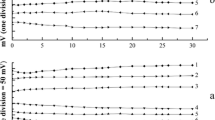Abstract
The method of potentiometric titration with a copper electrode is used for the determination of the total acidity and concentration of citric acid (CA) in identifying the adulteration of wines. The procedure is suitable for the determination of citric acid in wines in the range from 0.1 to 3.5 g/L in the presence of 30-fold amounts of tartaric, acetic, malic, succinic acids and a 10-fold amount of oxalic acid after the separation of organic carboxylic acids on an AV-17-8 anion exchanger. The procedure was developed and certified for the potentiometric determination of the mass fraction of citric acid in table wines and wine materials with an error not exceeding 20%. The criteria (mass fraction of citric acid, the percentage of citric acid in the total acidity, and the shape of the curves of potentiometric titration) were proposed for revealing the adulteration of the acid composition of wines.
Similar content being viewed by others
References
MR (Methodological Guidelines) 004-01: Examination of the Quality of Grape Wines, Moscow: Mosekspertiza, 2001.
GOST (State Standard) 51621-2000: Alcoholic Products and Raw Materials for Their Production. Methods for the Determination of Titratable Acids, Moscow: Izd. Standartov, 2003.
GOST (State Standard) R 52391-2005: Wine Production. Method for the Determination of Citric Acid Mass Concentration, Moscow: Standartinform, 2005.
Mato, I., Suarez-Luque, S., and Huidobro, J., Food Res. Int., 2005, vol. 38, p. 1175.
Wu, C.H., Lo, Y.S., et al., J. Chromatogr. A, 1995, vol. 716, p. 291.
Haselbe Kiyoshi et al., Fresenius Z. Anal. Chem., 1989, vol. 233, p. 19.
Hikima, S. et al., Electroanalysis, 1992, vol. 4, p. 801.
Naumenko, L.F., Buneeva, N.M., Korneeva, R.N., et al., Zh. Anal. Khim., 2004, vol. 59, no. 3, p. 327 [J. Anal. Chem. (Engl. Transl.), vol. 59, no. 3, p. 291].
Chen, Z.L. and Hibbert, D.B., J. Chromatogr. A, 1997, vol. 766, p. 27.
Casella, I.G. and Gatta, M., J. Chromatogr. A, 2001, vol. 912, p. 223.
Marhol, M., Ion Exchangers in Analytical Chemistry: Their Properties and Use in Inorganic Chemistry, Prague: Academia, 1982, part 1.
Osnovy analiticheskoi khimii (Fundamentals of Analytical Chemistry), Zolotov, Yu.A., Ed., Moscow: Vysshaya Shkola, 2004, vol. 2.
Author information
Authors and Affiliations
Additional information
Original Russian Text © E.A. Zakharova, M.L. Moskaleva, Yu.A. Akeneev, E.S. Moiseeva, G.B. Slepchenko, N.P. Pikula, 2011, published in Zhurnal Analiticheskoi Khimii, 2011, Vol. 66, No. 9, pp. 964–969.
Rights and permissions
About this article
Cite this article
Zakharova, E.A., Moskaleva, M.L., Akeneev, Y.A. et al. Potentiometric determination of the total acidity and concentration of citric acid in wines. J Anal Chem 66, 848–853 (2011). https://doi.org/10.1134/S1061934811090218
Received:
Accepted:
Published:
Issue Date:
DOI: https://doi.org/10.1134/S1061934811090218




